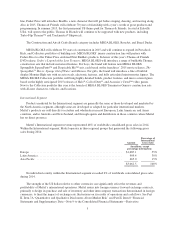Mattel 2014 Annual Report Download - page 21
Download and view the complete annual report
Please find page 21 of the 2014 Mattel annual report below. You can navigate through the pages in the report by either clicking on the pages listed below, or by using the keyword search tool below to find specific information within the annual report.Mattel’s business is highly seasonal and its operating results depend, in large part, on sales during the
relatively brief traditional holiday season. Any events that disrupt Mattel’s business during its peak
demand times could significantly, adversely and disproportionately affect Mattel’s business.
Mattel’s business is subject to risks associated with the underproduction of popular toys and the
overproduction of toys that are less popular with consumers. Sales of toy products at retail are highly seasonal,
with a majority of retail sales occurring during the period from September through December. In recent years,
many consumers have delayed their purchases until just before the holidays. As a result, Mattel’s operating
results depend, in large part, on sales during the relatively brief traditional holiday season. Retailers attempt to
manage their inventories tightly, which requires Mattel to ship products closer to the time the retailers expect to
sell the products to consumers. This in turn results in shorter lead times for production. Management believes
that the recent increase in “last minute” shopping during the holiday season and the popularity of gift cards
(which often shift purchases to after the holiday season) may negatively impact customer re-orders during the
holiday season. These factors may decrease sales or increase the risks that Mattel may not be able to meet
demand for certain products at peak demand times or that Mattel’s own inventory levels may be adversely
impacted by the need to pre-build products before orders are placed.
In addition, as a result of the seasonal nature of Mattel’s business, Mattel may be significantly and adversely
affected, in a manner disproportionate to the impact on a company with sales spread more evenly throughout the
year, by unforeseen events, such as terrorist attacks, economic shocks, severe weather, earthquakes or other
catastrophic events, that harm the retail environment or consumer buying patterns during its key selling season,
or by events, such as strikes, disruptions in transportation or port delays, that interfere with the manufacture or
shipment of goods during the critical months leading up to the holiday purchasing season.
Mattel has significant customer concentration, so that economic difficulties or changes in the purchasing
policies or patterns of its key customers could have a significant impact on Mattel’s business and operating
results.
A small number of customers account for a large share of Mattel’s net sales. In 2014, Mattel’s three largest
customers, Wal-Mart, Toys “R” Us, and Target, in the aggregate, accounted for approximately 35% of net sales,
and its ten largest customers, in the aggregate, accounted for approximately 45% of net sales. While the
concentration of Mattel’s business with a relatively small number of customers may provide certain benefits to
Mattel, such as potentially more efficient product distribution and decreased costs of sales and distribution, this
concentration may expose Mattel to a material adverse effect if one or more of Mattel’s large customers were to
significantly reduce purchases for any reason, favor competitors or new entrants, or increase their direct
competition with Mattel by expanding their private-label business. Customers make no binding long-term
commitments to Mattel regarding purchase volumes and make all purchases by delivering one-time purchase
orders. Any customer could reduce its overall purchases of Mattel’s products, reduce the number and variety of
Mattel’s products that it carries and the shelf space allotted for Mattel’s products, or otherwise seek to materially
change the terms of the business relationship at any time. Any such change could significantly harm Mattel’s
business and operating results.
Liquidity problems or bankruptcy of Mattel’s key customers could have a significant adverse effect on
Mattel’s business, financial condition and results of operations.
Mattel’s sales to customers are typically made on credit without collateral. There is a risk that key customers
will not pay, or that payment may be delayed, because of bankruptcy, contraction of credit availability to such
customers, weak retail sales or other factors beyond the control of Mattel, which could increase Mattel’s
exposure to losses from bad debts. In addition, if key customers were to cease doing business as a result of
bankruptcy or significantly reduce the number of stores operated, it could have a significant adverse effect on
Mattel’s business, financial condition, and results of operations.
15
























